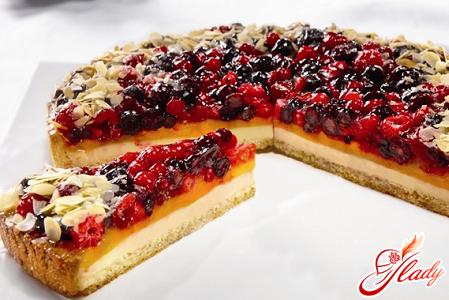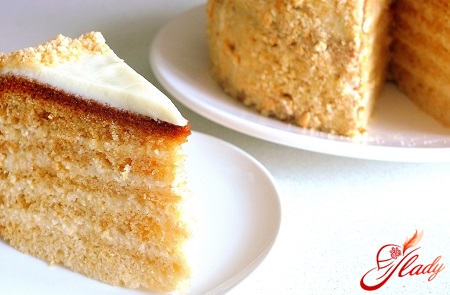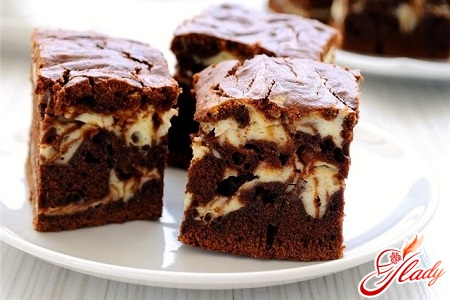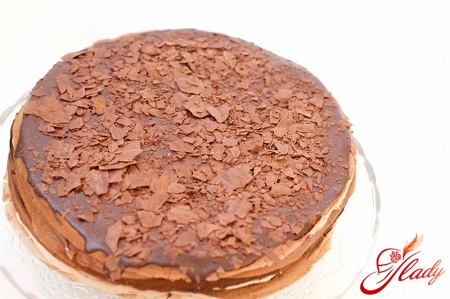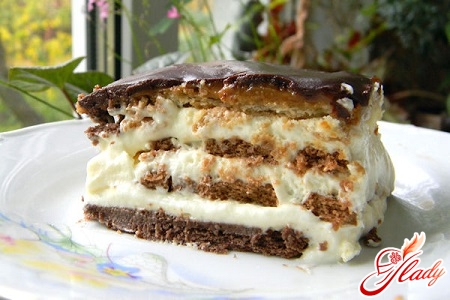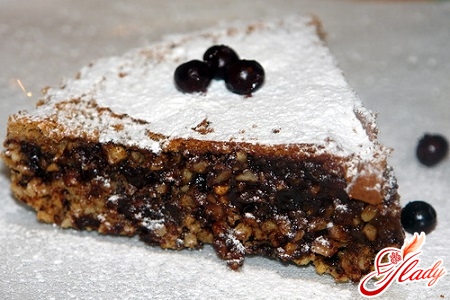 Sachertorte (Cake Sacher) - one of the mostpopular cakes in the world, a masterpiece of Austrian cuisine. His invention is due to the confectioner Franz Sacher, who lived in the 19th century. History says that for the first time this cake was prepared in 1832 for the guests of the Minister of Foreign Metternich. However, the dessert gained its popularity later, and, very indicative, it was due to the scandal.
Sachertorte (Cake Sacher) - one of the mostpopular cakes in the world, a masterpiece of Austrian cuisine. His invention is due to the confectioner Franz Sacher, who lived in the 19th century. History says that for the first time this cake was prepared in 1832 for the guests of the Minister of Foreign Metternich. However, the dessert gained its popularity later, and, very indicative, it was due to the scandal.
History of the scandal
The fact is that Franz's son, Edward, was alsoconfectioner. And he used his father's recipe, baking and selling cake in the authoritative confectionery "Demel", where he studied. After leaving the confectionery, he founded the hotel "Sacher", and, of course, the cake began to be sold there. The cake was gaining popularity, and with it grew the desire to be the owner of the original recipe from both sellers - "Demel" and "Zahera." They argued before the trial in 1934. Confectioners accused each other of using the trademark illegally and the like "sins". They argued until 1963, when they finally came to a peace agreement, having come up with two similar names. Cakes Sacher-branded Original Sacher-Torte (Original Sacher Sacher) began to be sold at the Sacher Hotel, and in Demeel a dessert was produced under the name Eduard Sacher-Torte (Cake Edward Zacher), the reason for this - some changes that Edward made in father's recipe, being a disciple in Demel. In the original recipe of Zaher, the cake consists of two or three crusts of chocolate biscuit with a layer of apricot jam. The top and sides of the cake are covered with chocolate icing. In the demeel "Zaher", the confiture is laid out only on top of the cake, before pouring it on the glaze. Cakes are served with whipped cream. And this is understandable. Whatever one may say, a chocolate biscuit will always be a bit dryish. A apricot jam is not able to sufficiently moisten it. However, these details can only interest us from the point of view of historical and cultural studies. To try a real cake Sacher, you need to go to Austria. Because the owners of the masterpiece do not intend to open the recipe of one or the other masterpiece. However, any masterpiece is a source of imitation. It's clear that for so many years, many attempts have been made to create something similar and unravel the recipe.
Riddle of the recipe
Cake Sacher recipe is, in fact, prettya simple combination of products and simple machinations with them. Of course, if we talk about variations and imitations. What actually contains the original recipe, we can only guess. One of the most striking examples of imitation was the popular in the USSR cake "Prague". Its author, the head of the confectionery shop of the Moscow restaurant of the same name, was at the beginning of his career a pupil of cooks-confectioners from Czechoslovakia. Given the proximity of this country to Austria, both geographically and historically, it's easy to guess where the inspiration came from the author of the Soviet culinary classics. In the Prague cake, in contrast to the Viennese counterpart, three crusts of chocolate biscuit are envisaged. As a layer, a creamy cream is used, consisting of butter, cocoa, condensed milk and chicken yolks. Berry or fruit jam is used only for the upper cake and sides of the cake. And in the end the cake is decorated with chocolate fondant or chocolate icing. The Russian housewives are trying to figure out what lies behind the magic words "Sacher cake recipe". Similar recipes are found on almost every culinary site or blog. We do not lag behind. And offer our version of the cake.
Recipe one, basic
For biscuit:
- 150 g chocolate
- 30 g of powdered sugar
- 180 g of sugar
- 2 tbsp. l. cream
- 150 g of butter
- 6 eggs (divided into squirrels and yolks)
- 150 g of flour
- Apricot jam for impregnation
For glaze:
- 40 g of butter
- 20 g of powdered sugar
- 50 g of cocoa
- 3 tbsp. l. hot milk
And also - a form for baking, non-stick, withdetachable sides, or silicone, or just one that, you are sure, will not let you down. The size of the form - 23-25 cm, can vary. The height of the biscuit depends on it and how much time it takes to bake it. In too large a form, the biscuit will turn out to be thin, and it will be difficult to cut it. In too small, he can not bake, getting too high. Therefore, if the form is all small, do not use all the ready-made dough. Make it a separate small biscuit and use it at your own discretion. Cooking process: First you need to turn on the oven and let it warm up to a temperature of 175-180 degrees. Prepare the form, you can lay the bottom of the baking paper for reliability (to make the sponge cake easier to extract), grease with oil. Dough. Chocolate needs to melt. To do this, it can be grated or simply smashed, placed in a saucepan on a small fire. This process is not easy, because chocolate tends to burn. Watch carefully. It is better to remove the saucepan from the fire before waiting for the smell of burnt chocolate. We put it aside, we are engaged in sugar and butter. Mix them until smooth, add cream and yolks. There we send warm chocolate. In a separate bowl, whip the proteins with sugar powder. In the chocolate-creamy mass, we begin to gradually introduce flour. It is not necessary to pour the entire portion at a time, it is better to do this in several stages. So you can mix better, avoid lumps and excessively steep dough. Flour from different manufacturers in different ways absorbs liquid. Therefore, perhaps you will need a little more of it or a little less to achieve the desired consistency of the test. It should be quite thick, because there is still the addition of proteins ahead. Proteins are injected into the dough gently, slightly mixing with a spoon. If you put too much effort, the dough will not turn airy. So, the dough is ready. We put it into a prepared baking dish and send it to the oven. Once again we look at the temperature. If it is lower than necessary, the biscuit can "fall off" during the baking process. And it turns out unattractive cake. If the temperature is too hot, the dough will immediately grasp from above, and not rise as needed. We keep our creation in the oven for 35-50 minutes. Again, time depends on the size of the form. The more it is, the less time it takes to bake. After 15-20 minutes, peer into the oven to make sure that the dough rises, whether it happened accidentally "over the coast" (this may be if you put a lot of dough into a small form). After about 35 minutes, you can try a biscuit for readiness. With a toothpick or a ray, pierce it into the heart itself. If dry, the biscuit is ready. Be careful, especially if you bake for the first time. Chocolate biscuit because of its color will burn unnoticed by the eyes. So do not overdo it if you do not want to get chocolate embers on the way out. We take out the biscuit from the oven and let it cool down a little. We remove it from the mold and cool it on the grate. Why on the grid? This is the only way to make the cold biscuit dry from the bottom. Cooled on a plate or cutting board, it will be wet and damp from below. The laws of physics, you know. Next is the procedure for cutting biscuit along. If you are lucky, and its sides after cooling have remained soft and soft, you can do with a thin strong thread. Suitable and fishing line, and even dental floss. If the sides have dried up and formed a crispy crust (this is possible, not terrible), then you should arm yourself with a sharp thin knife. So, by eye, we estimate where the "equator" of our biscuit passes. And on this line we surround the cake with a thread. The first time will be difficult, then it's easier. Slightly pull the thread so that it sticks into the sides of the biscuit. We cut the ends of the thread crosswise and continue to cut the crumb. The thread will cut deep into the biscuit from all sides, until it is in the middle and stretched out in your hands in one line. Now you can divide the biscuit into two perfectly flat halves! If you need to apply a knife, just cut it in a circle, and then pass the thread there. And then - as described above. Ready cakes should be smeared with jam and "collect" the cake. You can warm it up with jam so that it absorbs better. Spread also the sides of the cake and leave it absorbed. While preparing the icing. Heat and melt butter. We add milk, we interfere with cocoa and powdered sugar, previously combined into one whole - so cocoa is easier to dissolve, without turning into lumps. Slightly boil the icing in a saucepan, ideally - in a water bath. Finished glaze poured cold cake. Just wait a little longer for it to freeze - and you can start tasting. For tomorrow, the cake will be even more delicious (if, of course, something remains of it).
Variations
Depending on your preferences andthe recipe can be enriched with additional ingredients. So, instead of all portions of flour you can take a part of the flour, and a part - ground almonds (almond flour). This will give the biscuit a special taste and texture. You can also add a little (20-40 ml) of apricot liqueur to the dough. If you are afraid that the sponge cake will not rise, you can hedge by adding a baking powder (see the package for the proportions, but usually it's about a teaspoon or slightly more). One of the recipes found on the expanses of the world's network, suggests introducing a biscuit crumb into the dough (then you need to take less flour). The baby will make the dough more airy. Another variation is to impregnate the cakes with liqueur before lubricating with jam. This move will allow the cake to be softer and wet. In general, as you understand, preparing a cake for Sacher is a matter not only of skill, but of fantasy. Having an idea of the basic laws of baking, you can easily and naturally experiment with ingredients and tints of flavors. Do not forget only that even the most mediocre cake will seem amazingly tasty if you share it with good people in a pleasant atmosphere.
And also a compatriot ...
For those who are a patriot and prefer domestic classics to any foreign miracle, we offer a short recipe for the Prague cake. For biscuit:
- 4 eggs
- 200 grams of sugar
- 200 grams of sour cream
- 0.5 teaspoons of soda (quenched 1 teaspoon of vinegar) or 1 tsp. baking powder.
- 200 g condensed milk with sugar
- 3-4 tablespoons cocoa powder (for your taste)
- 2 tbsp. flour (you may need a little more)
For cream:
- 200 g of condensed milk
- 300 g of butter.
- 2 tablespoons powdered sugar
- 1 tbsp. cocoa
We beat eggs and sugar, pour in the milk. In the flour, we pour cocoa, baking powder and gradually introduce into the milk-egg mixture. If you use soda, then you need to add it to the ready-made dough, at the last stage. The dough should turn out thick. We spread the dough into a mold, we send it to the oven, heated to 180-200 degrees and bake until ready (about an hour). At this time, prepare the cream. Mix the butter with milk, pour a mixture of powdered sugar and cocoa. Beat the mixer to the splendor. Ready biscuit should be cooled and cut into three equal cakes. Corgi generously grease with cream and collect the cake. The remaining cream is consumed on the top and sides of the cake. The cake goes to the refrigerator to freeze. In parallel, the icing is prepared (see the recipe for the cake "Sacher"). After 30 minutes, you can get the cake from the fridge and cover it with glaze. And also decorate with chocolate chips. Done! Like its Austrian counterpart, the cake is unlikely to be liked by those who like a wet melting biscuit. And there, and here the biscuit will be rather dense, dryish. How to fix it, was written above. As an impregnation, you can use chocolate or coffee liqueur or cognac. Or just cool coffee. Only this will be another cake ... We advise you to read:




